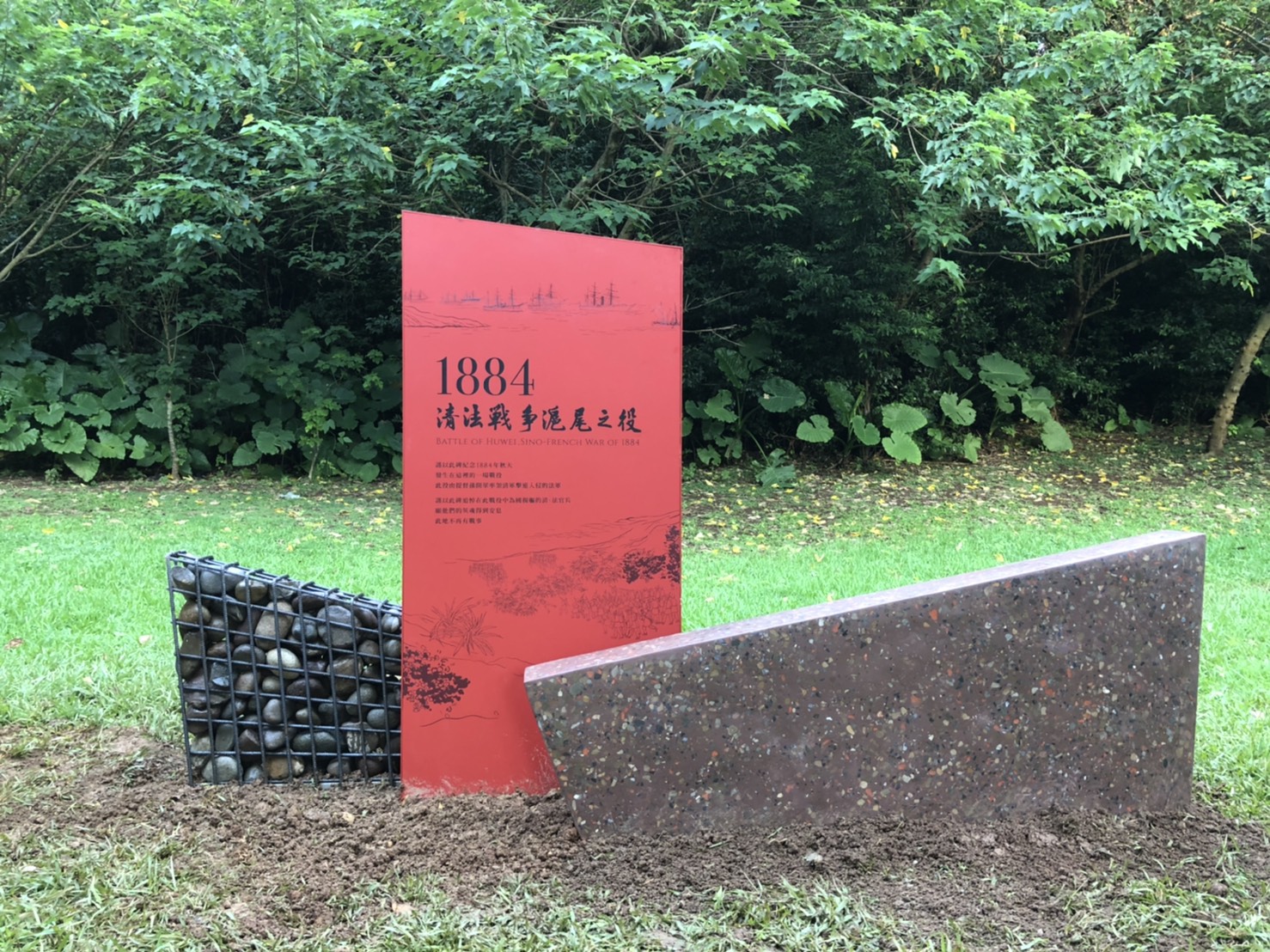 清法戰爭滬尾之役紀念碑
清法戰爭滬尾之役紀念碑清法戰爭滬尾之役文化路徑
紀念1884年秋天發生在這裡的清法戰爭滬尾之役,此役由提督孫開華率領清軍擊退入侵的法軍。
謹以此碑追悼在此戰役中為國捐軀的清、法官兵。願他們的英魂得到安息,此地不再有戰事。
一、概述
以清法戰爭滬尾之役相關點位,搭配文化路徑之概念,規劃相關場域之導視系統。透過紀念碑及導覽解說牌的設置,讓民眾了解淡水地區重要歷史經驗,經由科技互動方式,深入介紹各區域背景故事,讓民眾可以透過手機或行動電腦等裝置,進一步認識淡水豐富的歷史意涵。來淡水遊玩的旅客也可以跟隨著清法戰爭滬尾之役文化路徑,自由規劃自主導覽的行程,並不定期辦理專場導覽。
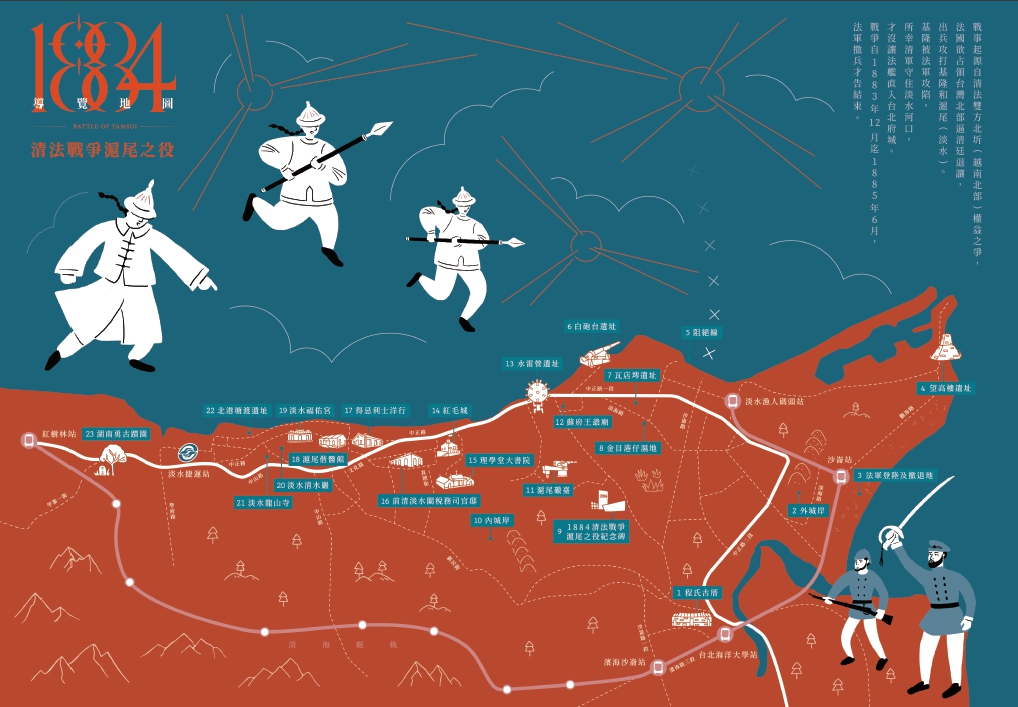 文化旅遊地圖
文化旅遊地圖二、文化旅遊地圖
文化路徑各點可透過下列交通方使抵達:
滬尾砲台(忠烈祠球場)部分,民眾可搭乘包括757、837、857、870、872、873、880、883、藍海2線、紅26、836等11條公車路線,其中836公車可直達,平日假日皆有行駛,其餘路線配合短程步行500公尺即可抵達滬尾砲臺。
滬尾砲台公園及天生國小部分,民眾亦可搭乘757、857、870、872、873、883、藍海2線、紅26等8條公車路線抵達「天生國小」站,步行即可抵達天生國小、滬尾砲台公園及金目港仔濕地等地點。
程氏古厝部分,可搭乘至淡水輕軌濱海沙崙站步行約500公尺可抵達程氏古厝。
民眾利用捷運、公車、輕軌、微笑單車及短程步行等交通方式,即可抵達清法戰爭文化路徑各地點。
三、清法戰爭滬尾-文化路徑導覽活動 (109年活動)
1.活動路線:
清軍之路:濱海沙崙站搭小巴-砲台公園紀念碑(講解清軍如何防守)-天生國小大門旁(金目港仔溼地)-瓦店埤-阻絕線-白砲台-水雷營-得忌利士洋行-偕醫館-解散賦歸
法軍之路:濱海沙崙站搭小巴-程氏古厝-沙崙海水浴場(法軍登陸及撤退地)-望高樓-白砲台-天生國2.集合地點:輕軌-濱海沙崙站。(全程搭乘小巴,各解說點需上下車)
3.活動人數:每場次預計17位。
4.費用: 免費。
注意事項:
1.為避免影響其他民眾權益,如無法出席者請勿報名。
2.未成年須由家長陪同,陪同家長亦須同場報名正取。
3.報名資料請填寫正確,俾利活動投保作業。
4.活動行程請自備飲水、防曬用品、雨具等個人用品。
5.活動為導覽行程前5-10分鐘集合,逾時不候。
6.每場活動報名人數未滿10人或遇不可抗力之因素(颱風、地震或其他因素)該場次取消。
7.主辦單位新北市立淡水古蹟博物館保有變更、調整行程,及最後解釋權。
程氏古厝 Cheng's Old Residence
為新北市最早公告登錄的歷史建築(2003年),也是淡海新市鎮第一期開發區碩果僅存的前清傳統民宅建築,彌足珍貴。古厝為典型三合院格局,採用唐山斗磚和山牆瓦衫,周遭有竹圍環繞、渠水流過,大體可以呈現前清時期,淡水地區農家厝宅的特色與居家環境。古厝建築年代不詳,大約在清光緒年間。由於在1898年(明治31年)的《台灣堡圖》上,可以發現古厝左後方和右前方,有類似清軍土壘的圖示,以及早年古厝旁留有疑似土壘殘跡的照片,因此有些學者認為該土壘為清法戰爭時龔占鰲駐守之營地,但如據李鴻章奏摺,龔占鰲埋伏在假港(港子平),應非此處(大庄)。程氏古厝與清法戰爭的關連性,仍有待進一步的研究。(文:張建隆)
He first historical building to be registered in New Taipei City (in 2003) and the sole surviving example of a traditional private residence from the Qing Dynasty in the Danhai New Town Phase 1 Development Zone. The historic residence follows the classical courtyard house layout. Built in the Tangshan brick pattern with gables and pinned tiledes, it was surrounded by bamboo groves and had its own water channel. It is representative of farmhouses in the Tamsui region during the Qing Dynasty. Actual date of construction is unknown, but it was probably built during the Guangxu Era. The Map of Fortifications in Taiwan from 1998 (31st Year of the Meiji Era) shows Qing earth fortifications to the rear left and front right of the historic residence. Early photos of the residence also show what appears to be ruined fortifications. Some scholars therefore believe that the fortifications were built by Gongzhanao for his main camp during the Sino-French War. Reports submitted by Li Hong-zhang however suggested that Gongzhanao set up his ambush at Jiagang (Gangziping) rather than here (Dazhuang). Further research is therefore necessary to clarify the link between the Cheng's Old Residence and Sino-French War. (Text: Jian-long Chang)
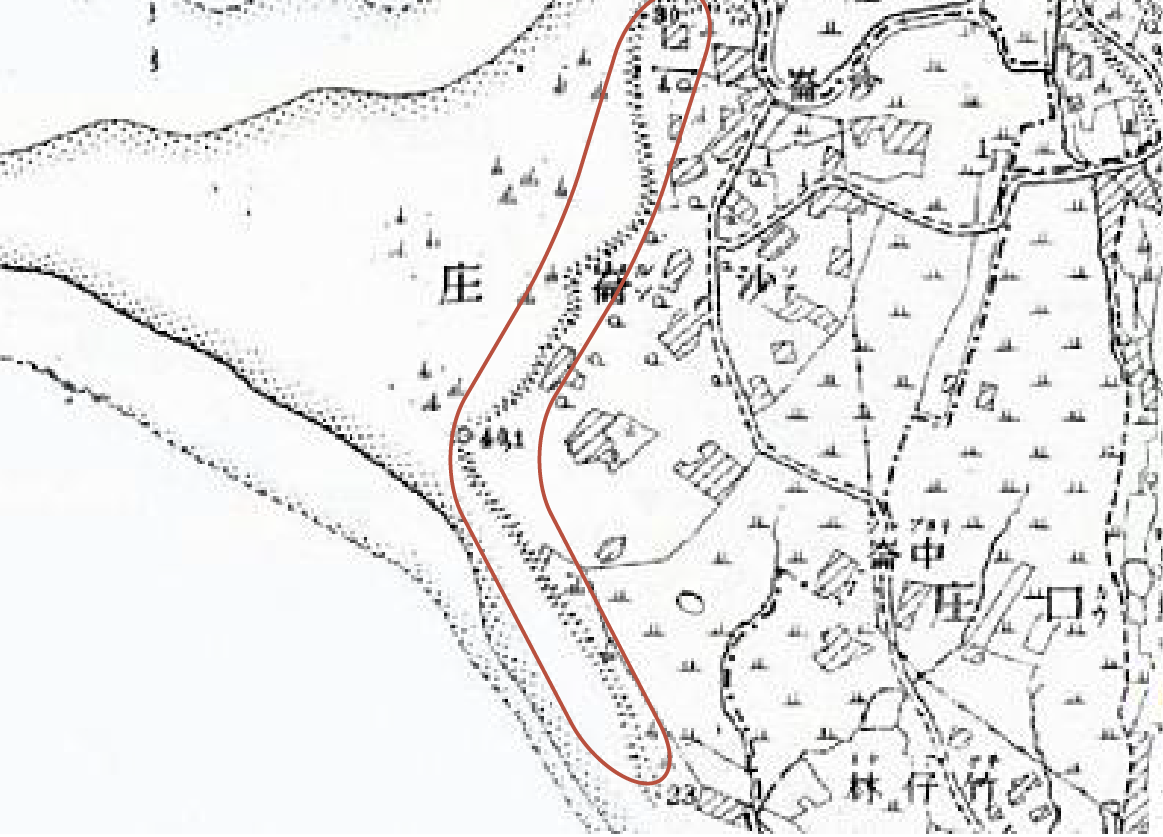 外城岸地圖
外城岸地圖外城岸 The Outer Defensive Wall
前清防禦工事,堆土夯實築造之土堤。從白砲台附近繞過沙崙庄,至港子平公司田溪畔,蜿蜒綿延約兩公里餘。因該土堤立基於沙崙地,坡體較為脆弱,加以多處已被闢建為民宅、道 路、墓地等,幾乎已難見原貌。 據張崑振2015年之調查,僅殘存太子宮、沙崙停車場、百姓公,以及後備學校等4個區段可以尋覓土堤樣貌。尤其是後備學校段保存較為完整。這4段土堤高度從3米到4米不等,寬度則從25公尺到36公尺不等。由於1884年10月8日法軍登陸戰相關史料中,並未有外城岸之記載,唯光緒11年(1885)春三月據傳聞繪製的「滬尾形勢」圖,首次出現外城岸部署,但1888年地圖卻無之。推測或係法軍登陸失敗後,清軍為加強防備所構築,日後又陸續補強而成?(文:張建隆)
Fortifications built during the Qing Dynasty. The embankment of rammed earth stretched for over two kilometers from Fort Blanc past Shalunzhuang to the bank of Gongsitian River at Gangziping. Being on sand dunes however meant the embankment was less resistant to erosion. Many parts have also been turned into private homes, roads and cemeteries so little of it remains intact today.
A survey conducted by Kunzheng Zhang found only four sections of the earthen embankment can be seen now at Taizih Temple, Shalun Car Park, Baixing Temple and the Reserve Mobilization and Management School (RMM School). The RMM School section in particular is relatively well preserved. The four sections range from 3 to 4 meters in height and their width ranges between 25 to 36 meters.
The Outer Shore Wall is not mentioned in any of the records related to the French landing on October 8, 1884. They first appeared in the Hobe Map drawn in the Spring of 1884 based on local stories but are not shown in the 1888 map. The embankment may have therefore been built by the Qing garrison after the failure of the French landing and fortified even further at a later date. (Text: Chang Jian-long)
法軍登陸及撤退地 Landing and Withdrawal Site of French Army
1884年10月8日上午,600名法軍和2個水雷兵分隊,搭乘登陸小艇,在法艦炮火的掩護下,於9點35分抵達沙崙海灘。法軍到達陸地後立即整隊,編組成5個中隊,9點55分開始向前推進,目標是佔領水雷營。不久,就與嚴陣以待的清軍展開一場激烈的戰鬥。
到接近中午時,法軍因傷兵後送以及左翼一度遭清軍切斷,於是開始撤退。從左方斜行開始,相互掩護,後撤至原登陸海灘,等待登陸小艇前來接運。然而清軍隨後追來,眼看即將被圍困在海灘上,所幸Vipére砲艇即時出現,以砲火壓制清軍攻勢,法軍才能順利登上登陸小艇,返回母船。但在慌忙中,一門旋迴砲不慎從一艘登陸小艇落入海中。(文:張建隆)
On the morning of October 8, 1884, 600 French troops and two sapper detachments landed at Shalun Beach in small boats under covering fire from French warships. The French landed at 9:35 a.m. and immediately organized themselves into five companies to begin pushing forward at 9:55 a.m.. Their objective was the Sea Mine Camp. Fierce fighting soon broke out with entrenched Qing troops.
The French began withdrawing around noon as the evacuation of the wounded and their left flank was cut off at one point by Qing troops. They began withdrawing in echelon from the left and staged a fighting withdraw back to the beach they landed at to wait for the boats. The Qing troops closed in however and threatened to trap them on the beach. Fortunately for the French, the gunboat Vipére arrived in time to blunt the Qing attacks with cannon-fire and they were able to get back into their boats and return to the ships. In the confusion, a Hotchkiss canon-revolver on a boat fell overboard. (Text: Chang Jian-long)
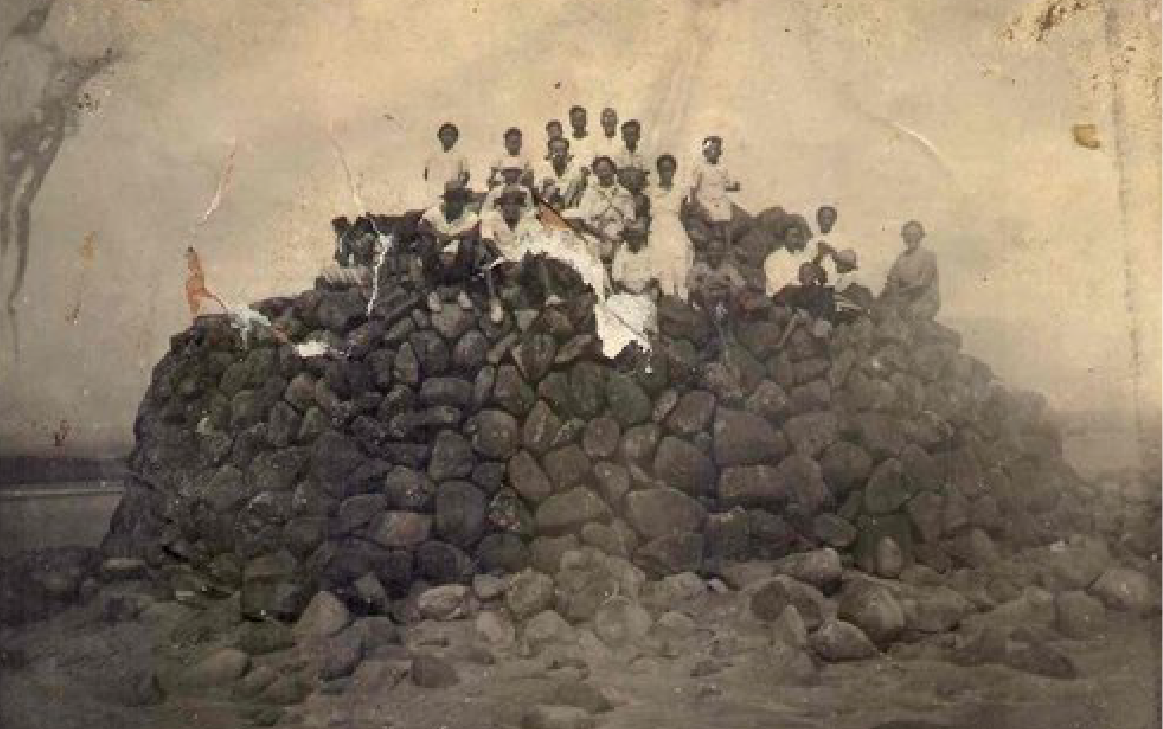 望高樓遺址
望高樓遺址望高樓遺址 Former Site of Wanggaolou Lighthouse
全臺第一座燈塔,建於嘉慶元年(1796),位於淡水河口北端。由於淡水河口東北方的公司田溪口,在夜晚或天色昏暗時,很容易被誤認為是淡水河口,經常發生擱淺事件,造成船、貨莫大損失,因此往來於泉州和廈門的交易商和滬尾街的地方管事發起興建燈塔,向諸船東募款,每船捐銀壹大元。此外,商船每次進港繳付銀4錢,做為燈塔營運經費。請福佑宮住持代為雇用工人,每晚為燈塔點燃燈火,以為照明。該「望高樓碑誌」今仍鑲嵌於福佑宮廟內牆上。1884年10月8日中午,法軍敗退,準備撤兵時,一名信號兵爬上望高樓,向停泊在海上的法艦發出信號:「彈藥用罄,損失重大,我們非撤退不可。」法軍艦於是派出登陸小艇將海灘上的法軍運回母船。(文:張建隆)
The first lighthouse in Taiwan was built in 1796 on the north side of the Tamsui River mouth. As the mouth of Gongsitian River to the northeast is easily confused with the Tamsui River mouth itself at night or in poor light, ships frequently ran aground resulting in serious damage and loss of cargo. Merchants trading between Quanzhou and Xiamen as well as local managers at Hobe Street therefore asked the owners of each ship to donate one silver yuan towards the construction of a lighthouse. Each ship was also charged 4 qian of silver each time they entered port to pay for lighthouse operations. The abbot of Fuyou Temple was asked to hire workers for lighting the lighthouse every night. A stele on the Wanggaolou arrangement is still set into the interior wall of the temple today. When the French were defeated on October 8, 1884, and were preparing to withdraw at noon, a signalman climbed to the top of Wanggaolou and signaled to the French warships anchored off the coast “Out of ammunition, heavy losses, we must withdraw.” The French warships then sent boats to transport the French troops on the beach back to their ships. (Text: Jianlong Chang)
阻絕線 Blockade
1884年8月5日,法軍第一次進犯基隆,為防範法艦入侵淡水,清軍開始在淡水河口最窄處,從八里挖子尾到滬尾對岸,開始將載滿石塊的戎克船鑿沈河底,並部署水雷,構成一道阻絕線。
到了8月29日傳來福州被轟消息,閩江艦隊幾遭殲滅,引起震撼,滬尾清軍加緊沉船塞港和布雷作業。10月2日滬尾砲戰後,當天晚上法砲艇Vipére搭載水路技師Renaud和水雷官Merlin等人到淡水河口偵察航道及阻絕線未果。翌(3)日,Vipére砲艇再率兩艘小艇前往偵查該阻絕線,當小艇試圖打撈阻絕線上的游標和電線時,被陸上守軍發現,立即通知水雷營引爆水雷,以致小艇附近水面發生猛烈爆炸並激起浪花。
終究,這道阻絕線有效阻擋了法國軍艦,也算是滬尾之役清軍致勝的關鍵之一。(文:張建隆)
The French attacked Keelung for the first time on August 5, 1884. To prevent a French incursion into Tamsui, the Qing defenders began sinking junks filled with rocks at the narrowest point of the Tamsui River mouth between Bali’s Waziwei and Hobe(Tamsui) on the other side. Sea mines were also deployed to build a blockade.
When word was received on August 29 that Fuzhou had been bombarded and the Minjiang Fleet virtually annihilated, the news sent shockwaves through the community and the Qing garrison at Hobe stepped up their efforts with blockade ships and sea mines. After the artillery battle at Hobe on October 2, the French gunboat Vipére with port engineer Renaud, sea mine officer Merlin and others aboard made an unsuccessful attempt to scout the navigation channel and blockade. The next day (October 3), the Vipére and two launches attempted to clear the channel. When a launch tried to recover the buoys and electric cable on the blockade, they were discovered by the defenders on the shore and the Sea Mine Camp was notified. The detonation of sea mines almost caught one of the launches.
The blockade was ultimately successful in blocking the French warships and can be considered to have played a crucial role in the Qing victory at the Battle of Tamsui. (Text: Chang Jian-long)
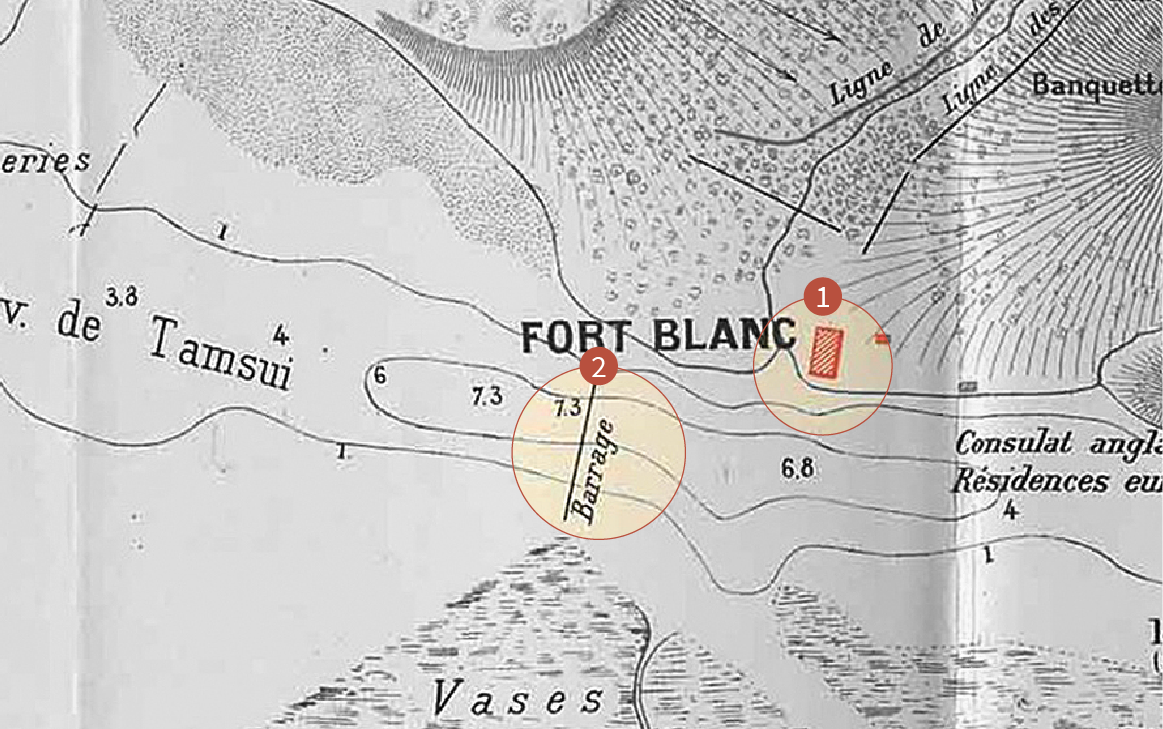 紅色方塊,Fort Blanc(白砲台);Blockade(阻絕線)
紅色方塊,Fort Blanc(白砲台);Blockade(阻絕線)白砲台遺址(附阻絕線) Former Site of Fort Blanc (and Blockade)
位於金目港仔溪口南側,約在今海巡署位置。原係道光年間鴉片戰爭時為防範英艦所築之砲台,因年久失修,到了同治年間滬尾開港後,已淪為輪船進港之指標而被稱做白堡(White Frot)。1884年秋,法艦犯臺時,清軍於其前方堆置沙包,並安裝一門克魯伯大砲,予以改善補強。是年10月2日早上,清法雙方展開砲戰,白砲台因位置太過暴露,目標明顯,不久即遭法艦炮彈摧毀。
當時清軍派兵駐守白砲台附近,負責監看阻絕線,一有敵艦靠近,立即通報水雷營,引爆水雷。阻絕線在淡水河口最窄處,從八里挖子尾到今海巡署附近。將載著石塊的戎克船鑿沉河底,構成一道人工的阻絕線,並在阻絕線後方部署十枚水雷,以防止法艦進入。(文:張建隆)
Located on the south bank of Jinmuzi River mouth around where the Coast Guard Administration is today. First built in the Daoguang era to defend against British attacks during the Opium War, it was allowed to fall into ruin. When Hobe (Tamsui) was opened up to foreign trade during the Tongzih Era, it had become the navigation marker called the White Fort by ships entering the harbor. When French warships attacked Taiwan in the fall of 1884, the Qing forces reinforced the battery with sandbags and installed a Krupp cannon. On the morning of October 2, an artillery duel commenced between the Qing and the French. Fort Blanc’s exposed position meant it was soon destroyed by French bombardment.
Qing troops had been stationed near Fort Blanc to stand guard over the Blockade. If enemy ships were to approach, they would notify the Sea Mine Camp to detonate the sea mines. The Blockade was located at the narrowest point of the Tamsui River mouth. It ran from Wazihwei in Bali to the present-day Coast Guard Administration station. Junks filled with rocks were sunk to create a Blockade. Ten sea mines were also deployed behind the Blockade to keep the French ships at bay. (Text: Chang Jian-Long)
瓦店埤遺址 Former Location of Wadianbi
瓦店埤昔日為儲水灌溉之埤塘,上方為俗稱「金目港仔」(音譯)的溼地。瓦店埤設有水閘門,枯水期時關上水閘門儲水,雨季時則打開排水,排入小溪中,流向淡水河。溪上有一小橋,連通道路。1884年10月8日上午,法軍自沙崙海灘登陸,編成五個中隊後,朝向新砲台方向推進,目標是奪取水雷營。孫開華則率領擢勝後營清軍在油車口嚴陣以待。因受到溼地的阻擋,瓦店埤旁的小橋和小溪,就成為雙方急於突圍的通道。因此當孫開華率部向法軍衝鋒時,就在瓦店埤附近與法軍展開肉搏血戰。瓦店埤一帶因此成為此次戰役中交戰最為激烈之地。(文:張建隆)
Wadianbi was once a pond used for water storage and irrigation. Its upper reaches were wetlands locally known as Jinmugangzih. A water gate at Wadianbi was closed during the dry season to store water. During the wet season, the water gate was opened to let excess water flow into the stream and from there into the Tamsui River. A small bridge crossed the stream. On October 8, 1884, the French organized themselves into five companies after landing at Shalun Beach then advanced towards the new battery. Their objective was the capture of the Naval Mine Company. They were opposed by the Zhuosheng rear battalion under the command of Sun Kai-hua at Youchekou. The obstacle presented by the wetlands made the bridge and small stream next to Wadianbi a key choke point. When Sun led the charge on French troops, hand-to-hand combat took place around Wadianbi. This was therefore the scene of the heaviest fighting during the battle. (Text: Chang Jian-Long)
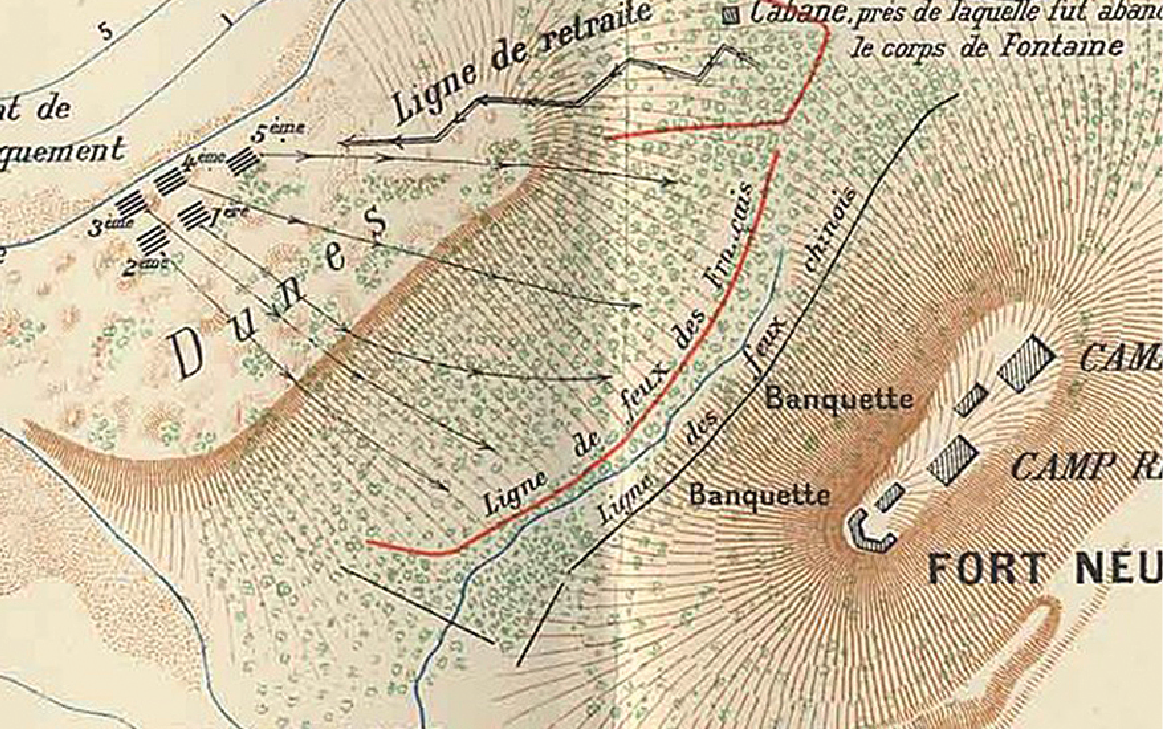 地圖
地圖金目港仔濕地 Wetland Mudflats
俗稱「金目港仔」(音譯)的這片溼地泥潭,水源可能來自公司田溪附近,其上游因天生國小興建操場埋入地下箱涵,如今已難覓其源頭。昔日溼地漫淹中崙一帶,從今天生國小操場附近綿延至「瓦店埤」,目前還保留其中一段。通過瓦店埤的水閘門後,溼地又回復為溪流,從今海巡署流入淡水河。溼地泥潭寬逾10丈,約30公尺多,難以通過,成為天然屏障。1884年10月8日法軍登陸後,往前推進時,在這裡受阻,與溼地對面的清軍相互駁火射擊,雙方各在溼地前緣,形成一條長達1500公尺的火線,成為這場戰役特殊的戰況。(文:張建隆)
The water source of the wetland mudflats known locally as Jinmugangzi may have been located near Gongshitian River. The source is hard to pinpoint today as the upper reaches of the river were paved over to construct the athletics field at Tianshen Elementary School. The wetlands once stretched as far as Zhonglun, running from the athletics field of Tianshen Elementary School to Wadianbi. Only a section of it remains today. The wetlands turn back into a river after passing through the water gate at Wadianbi to flow into Tamsui River where the Coast Guard Administration is located now. The wetland mudflats were more than 30 meters wide and formed a natural obstacle to all passage. After landing at Shalun Beach on October 8, 1884, the French advance was blocked here by Qing troops and they exchanged fire across the wetlands. The 1500m long frontline that eventually developed was the most unusual feature of this battle . (Text: Jian-long Chang)
1884清法戰爭滬尾之役紀念碑 Memorial for Battle of Tamsui During the Sino-French War of 1884
1884年10月2日,四艘法國軍艦在淡水外海,炮擊清軍陣地,開啟滬尾之役的序幕。炮戰中,清軍兩座砲台悉遭摧毀,傷亡約數十人。10月8日上午,600名法軍從沙崙海灘登陸,向油車口方向推進。清軍方面,由提督孫開華率領擢勝中、後、右三營約1500人應戰。雙方在戰線上相互駁火。俟進入短兵相接距離,孫開華率部衝鋒,在瓦店埤與法軍展開肉搏血戰。擢勝中營衝擊法軍右翼,埋伏在港子平的擢勝右營又屢次突破法軍左翼,加以法軍子彈即將用罄,傷兵後送引起恐慌,最後只好撤退。這場登陸戰於中午結束,交戰不到兩個小時,法軍陣亡及失蹤計17人,傷者49人;清軍傷亡約200多人,皆包含多名軍官,足見戰況之激烈,是為淡水史上的一大事件。(文:張建隆)
On October 2, 1884, as a prelude to the Battle of Tamsui, four French warships off the coast of Tamsui began bombarding Qing defensive positions. The bombardment destroyed both Qing batteries and inflicted dozens of casualties. On the morning of October 8, 600 French soldiers landed at Shalun Beach and began advancing on Youchekou. The Qing forces consisted of approximately 1500 men from three battalions of the Zhuosheng under the command of General Sun Kai-hua. The two sides exchanged fire before engaging in hand-to-hand combat with General Sun leading the charge at Wadianbi. The Zhuosheng center battalion attacked the French right wing while the Zhuosheng right battalion lying in ambush at Gangziping repeatedly broke through the French left wing. The French began running low on ammunition. Panic also broke out while the wounded were being evacuated to the rear so they were eventually forced to withdraw. The amphibious attack ended around noon and the fighting lasted no more than two hours. The French suffered 17 dead or missing, and 49 wounded; Qing forces suffered more than 200 casualties. The number of officers killed on both sides was a testament to the intensity of the fighting. The battle was a major event in the history of Tamsui. (Text: Chang Jian-long)
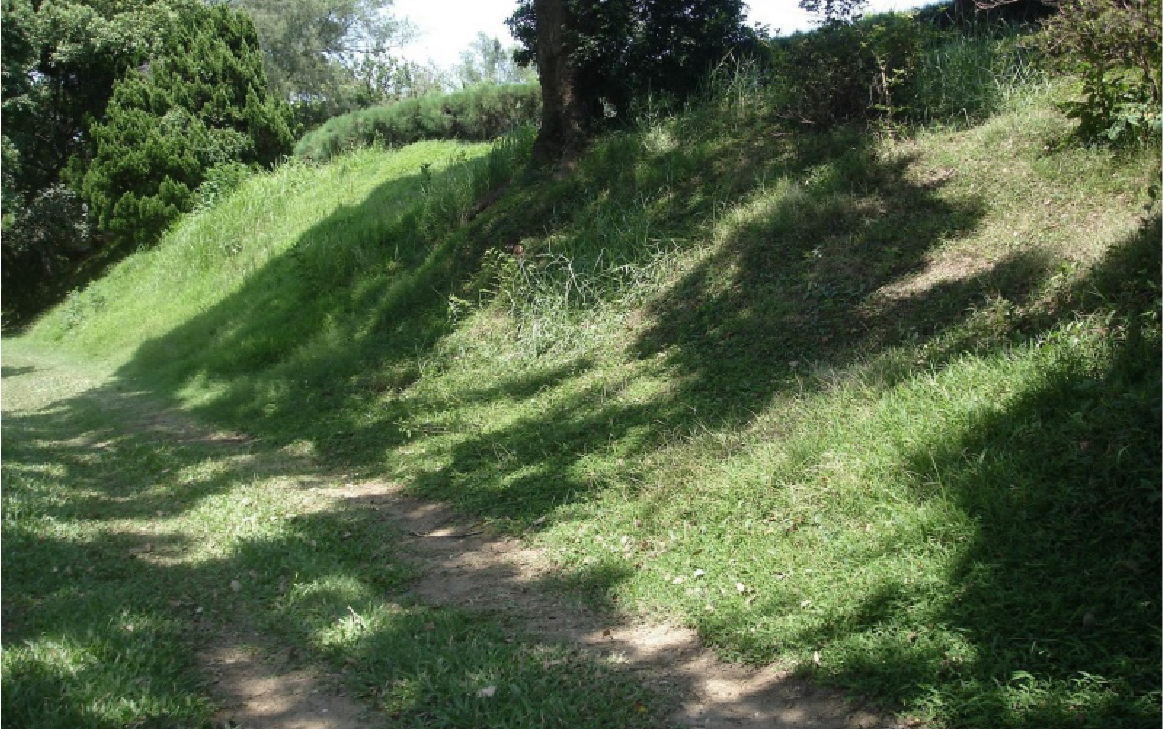 內城岸
內城岸內城岸 The Inner Defensive Wall
清法戰爭滬尾之役時清軍興建之防禦工事,當地人俗稱「城岸」。實則為人工夯實的土堤,下寬上窄,呈梯形,上寬約2米、下寬約4米,高約2米多,綿延1000多公尺。1884年8月2日,劉銘傳與孫開華、劉璈勘查滬尾地形,選擇在烏啾埔的制高點興建一座大砲台,以抵禦法軍艦砲的攻勢,並在該地築造一道防禦工事,從今高爾夫球場延伸至大庄、港子平一帶。此防禦工事,在10月2日的砲戰中發揮不小功用,雖法艦砲火猛烈,清軍躲在「城岸」後面,依然能保持戰力,以對抗法軍的登陸。該防禦工事,日後雖經高爾夫球場多次整地,但仍有一段被保留下來,成為1884年清法戰爭滬尾之役絕少留下的歷史見證,殊為難得可貴。(圖文:張建隆)
Defensive fortifications were built by the Qing military during the Battle of Tamsui in the Sino-French War of 1884. The local people refer to these as “Cheng-an” (City Defnsive Wall). The fortifications consist of an earthen embankment that is approximately two meters wide at the top and four meters wide at the base. The embankment has a height of over two meters and is more than a kilometer long. Liu Ming-chuan, Sun Kai-hua and Liu Ao inspected the terrain at Hobe (Tamsui) on August 2, 1884, and decided that a large artillery battery would be built on the high ground at Wuciupu to defend against the guns of French warships. Fortifications would also be built, running from where the golf course is today all the way to Dazhuang and Gangzihping. These fortifications would play a significant part during the artillery exchange on October 2. Qing defenders were able to shelter from the intense French bombardment behind the city defensive wall before emerging to fight the French landing armyparty. A section of the city defensive wall still remains today despite the many earthworks carried out at the golf course, making it a rare trace of the Battle of Tamsui during the Sino-French War of 1884. ( image & text: Chang Jian-long)
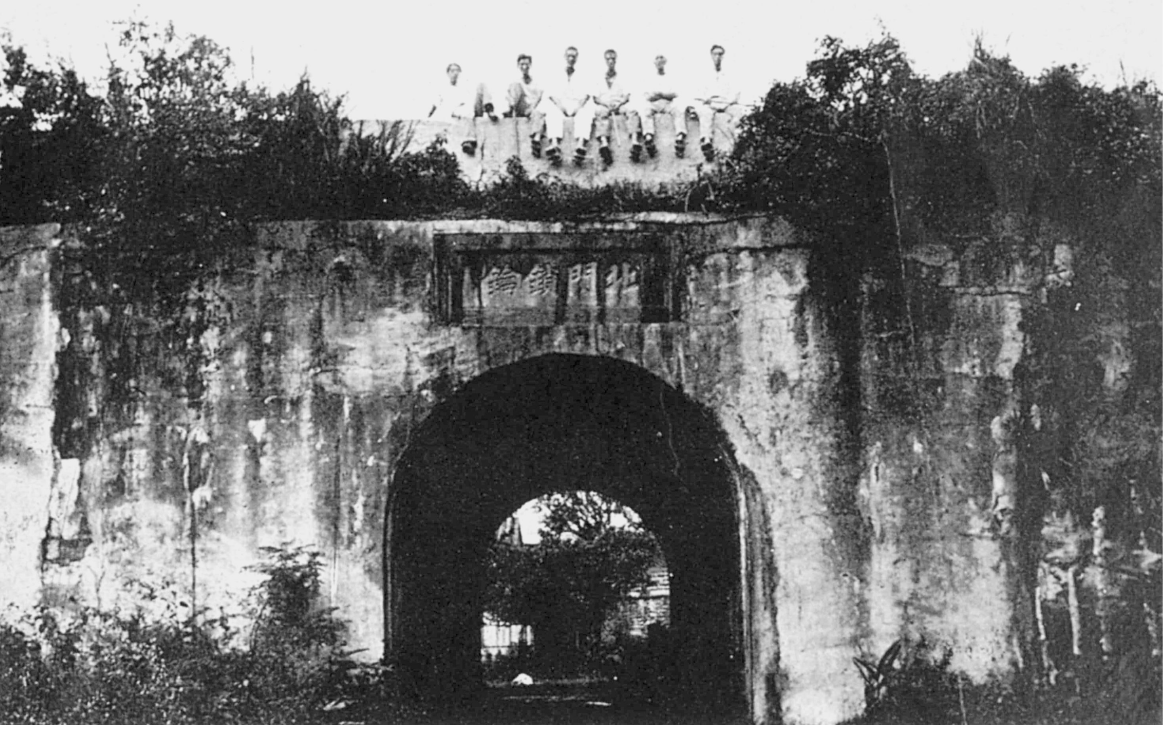 滬尾礮臺
滬尾礮臺 滬尾礮臺 Hobe Fort
1884年清法戰爭後,劉銘傳鑑於臺灣海防的重要,因此聘請德國籍技師巴恩士(Max E.Hecht Baons)負責督造,仿西洋礮臺圖形,於澎湖、基隆、滬尾、安平、旗後等五處海口,以鐵水泥築造10座新式礮臺,並向英國購買31尊阿姆斯脫朗砲,安裝於這10座新礮臺上。據小澤德平於1888年所繪《臺灣淡水港台北府局地圖》,當時滬尾礮臺已安裝4尊大砲,一朝向淡水河,一朝向淡水河口,一朝向沙崙外海,一朝向北淡水。可見滬尾礮臺竣工時間,至遲不晚於1888年(光緒14年)。又據《台島劫灰》,1895年時,滬尾礮臺4尊大砲,分別是12吋英國阿姆斯脫朗砲1尊;10吋阿姆斯脫朗砲1尊;12厘米德國博洪砲(克虜伯砲)2尊。可能是割臺前夕,全臺大砲重新部署調配的緣故。(文:張建隆)
Liu Ming-chuan recognized the importance of coastal defenses to Taiwan after the Sino-French War of 1884 so hired the German engineer Max E. Hect to supervise the construction of ten concrete Western-style forts at five ports: Penghu, Keelung, Hobe, Anping and Cihou. He also purchased 31 Armstrong Rifled Breech Loaders from England to arm these ten new forts. In Taiwan Tansui-kō, Taihoku-fu kyokuchizu, a map of Tamsui Port drawn by Tokuhei Ozawa in 1888, four cannons had been emplaced at Hobe Fort by then, with one pointed at the Tamsui River, one pointed at the Tamsui River mouth, one pointed at the waters off Shalun, and one pointed at northern Tamsui. Hobe Fort was therefore completed before 1888. The four cannons at Hobe Fort in 1895 consisted of one 12″Armstrong Rifled Breech Loader and one British-made 10″Armstrong Rifled Breech Loader, and two German-made 12cm Krupp guns. Changes may have been made to cannon deployments throughout Taiwan on the eve of Taiwan being ceded to Japan. (Text: Jian-long Chang)
蘇府王爺廟 Sufuwangye Temple
一名「水港廟」,為油車口當地船戶漁民所崇奉,主祀蘇府王爺。本尊由來,相傳乾隆年間,有船自唐山供奉王爺神像渡臺,於金包里外海遇風暴沈沒,僅謝九1人,攜本尊漂至附近海岸獲救。後來疫疾流行,多賴王爺驅瘟禳災,因獲當地居民信仰,香火以盛。建廟年代不詳,或在道光至咸豐年間。戰後幾經改築,規模日益擴大,但文物散失不少。農曆9月初9,蘇府王爺廟會,有送王船習俗,為當地一大盛事。1884年清法戰爭滬尾之役,相傳王爺顯靈,懼退法軍。提督章高元敬獻「威靈赫濯」匾額,可惜目前懸掛在廟中者為新造仿製品。(文:張建隆)
Also known as Shuigang Temple, the temple is dedicated to Sufuwangye (Baron Su) and is worshipped by sailors and fishermen in Youchekou. Legend has it that a ship was bringing the statue of Sufuwangye from Tangshan to Taiwan during the Qianlong Era when it sank in a storm off the coast of Jinbaoli. The only survivor was a man named Jiou Hsieh who was washed ashore along with the statue. When an epidemic later broke out in the area it was Sufuwangye who saved the local people, a miracle that turned them into devout followers. The temple itself was probably built between the Daoguang and Jianfeng period. The temple was expanded after World War 2 and its following expanded as well, though many relics are now lost. A Burning of the King Boat ceremony is held on the 9th day of the 9th lunar month every year and this is a grand occasion for the local community. In the Battle of Tamsui during the Sino-French War of 1884, Sufuwangye was said to have intervened and put fear into the French troops. A plaque was therefore presented by Governor Gaoyuan Zhang. Unfortunately, the plaque that now hangs in the temple is a modern replica. (Text: Jianlong Chang)
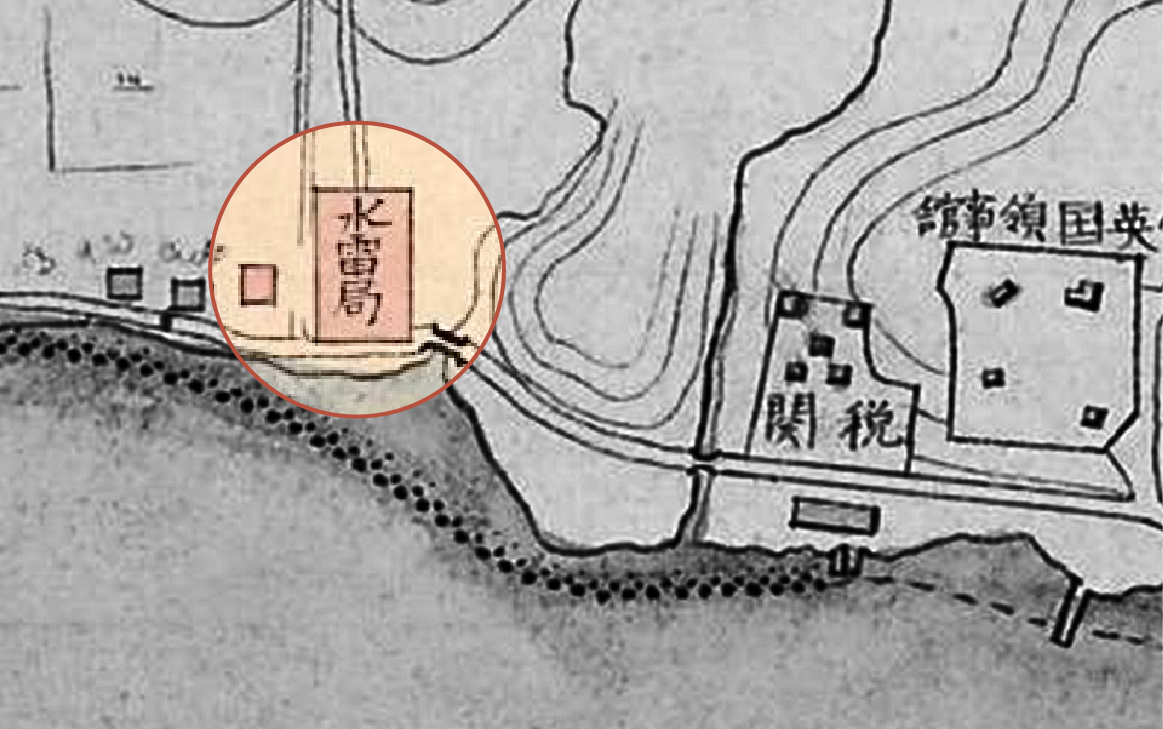 水雷營遺址地圖
水雷營遺址地圖水雷營遺址 Former Site of the Sea Mine Camp
位於米粉寮溪出河口右畔,約在今忠烈祠下面的路口和軍營附近。清法戰爭時,為防備法國軍艦從淡水河口入侵,清軍於河口最窄處沉船塞港,部署水雷,埋設點火線,設置水雷營,駐防水雷兵,並令士兵駐守於白砲台附近,負責監監看水雷阻絕線,一有敵艦靠近,立即通報水雷營,水雷兵以點火線引爆水雷。1884年10月8日,法軍登陸戰的主要目標,即是攻佔此水雷營,將阻絕線上的水雷逐一引爆,然後再由巡洋艦Triomphante用500公斤的黑炸藥,將阻絕線的障礙物炸掉,開闢出一條航道出來,讓法艦可以長驅直入。戰爭結束後,仍於此處設置水雷局。(文:張建隆)
The Camp was located on the right bank of the Mifenliao River mouth near the modern-day intersection below the Martyrs’ Shrine and military barracks. During the Sino-French War, Qing defenders sunk blockade ships and deployed sea mines at the narrowest point in the Tamsui River. Detonation cables were run to the Sea Mine Camp near Fort Blanc and the garrison had orders to explode the sea mines if enemy ships were to approach. The objective of the French landing on October 8, 1884, was to capture the Sea Mine Camp and detonate all of the sea mines on the Blockade. The cruiser Triomphante would then use 500 kg of black powder to clear a channel through the obstacles for the French warships to pass through. A Sea Mine Bureau was still established here after the end of the war.
紅毛城 Fort San Domingo
第一代安東尼堡,1642年11月落成,以荷蘭聯合東印度公司巴達維亞總督安東尼.范.帝門(Antonio van Demen)命名。當時是以竹子和泥土建造而成。不久因不堪大雨沖刷而崩壞,竹造房舍也屢遭回祿之災。因此於1644年4月重建第二代安東尼堡,為碉堡形式建築,當時設計是36呎四方,牆厚6呎,主要建材為石塊和磚、瓦等,石灰都從大員(臺南)運來。因海運不易,又屢遇風雨阻礙施工,直至1646年3月才完工,主體結構保留至今。由於是荷蘭人所建,俗稱紅毛城。同治6年11月(1887),租予英國為領事館。1884年清法戰爭滬尾之役,10月2日砲戰時,紅毛城後牆角曾遭炮彈擊中,所幸未有損傷。10月8日,孫開華率領清軍與登陸法軍激戰,不少外僑躲到紅毛城觀戰。(文:張建隆)
Fort Antonio was firstly completed in November 1642 and was named after Anthony van Diemen, the governor-general of the Dutch East-India Company at the time. As it was built out of earth and bamboo, the fort was soon damaged by rain. Bamboo houses also burned down. Construction of a second Fort Antonio commenced in April 1644. A square fortress measuring 36 feet on each side with walls 6-feet thick was built. The fort was built mainly out of stone, brick and tile, with all of the lime shipped from Dayuan (Tainan). The fort was not completed until March 1646 due to the shipping was not easy and the bad weather. The main structure remains intact today. As it was built by the Dutch it was known to locals as the Hongmaocheng (literally “Red Hair Fort”). In November 1867, it was leased to the British for use as their consulate. During the Sino-French War of 1884, the rear corner of Fort Antonio was struck by a shell from the French bombardment on October 2 during the Battle of Tamsui. Fortunately, it did little damage. On October 8, the Qing troop under the command of Gerneral Sun Kai-hua had a fierce fight with the landing French troop. (Text: Jian-Long Chang)
理學堂大書院 Oxford College
馬偕親自設計監造,1882年7月落成,命名為理學院大書院,英文以Oxford College(牛津學堂)稱之,乃為紀念加拿大牛津郡鄉親的盛情美意。1880年馬偕首次回加拿大述職,應邀到各地演講,報告在臺灣的宣教經驗,充滿傳奇的宣教成果,引起極大的轟動。故鄉親友為表達對其宣教的關心與鼓勵,由牛津郡當地報紙《守望評論報》發起興建神學院的募款運動,獲得熱烈的響應。總共募得6,215元加幣,作為在淡水興建學校的經費。牛津學堂雖然是培養傳教士的學校,但授課內容並不局限在研習教義和聖經研讀,還包括天文、化學、物理,地質、地理、生物、動物、植物等自然科學,以及衛生、解剖、藥理等醫學相關,也有體育、音樂等。可謂當時最先進的新式教育發祥地。
Oxford College in Tamsui was completed in July 1882. Its design and construction were supervised by George Leslie MacKay himself, and its name commemorated the support from his hometown of Oxford County in Canada. MacKay returned to Canada for the first time in 1880 to report on his work. He received many invitations to speak about his experience as a missionary in Taiwan, and his accomplishments became the talk of society at the time. People in his hometown wanted to show their support so the Sentinel Review, a local paper in Oxford County, launched a campaign to raise funds for the construction of a seminary. The campaign received an enthusiastic response and raised CAD 6215 towards the construction of a school in Tamsui. Oxford College may have been a school for training missionaries, but the curriculum went far beyond religious doctrine and bible study. It also covered sciences such as astronomy, chemistry, physics, geology, geography, biology, fauna and flora, as well as hygiene, anatomy, pharmacology and other medical topics. Physical education and music were included as well, making it one of the top institutions for modern education at the time.
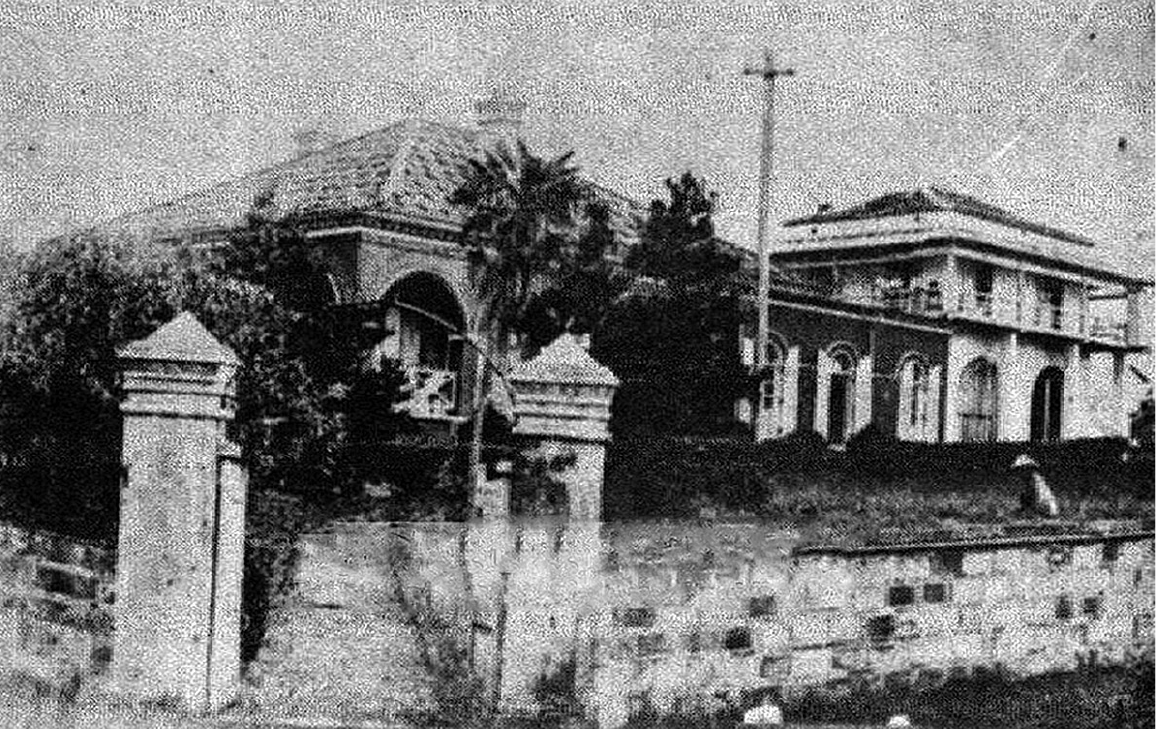 前清淡水關稅務司官邸遺址
前清淡水關稅務司官邸遺址前清淡水關稅務司官邸遺址 Former Site of Tamsui Customs Officer's Residence
同治元年(1862),滬尾港正式開埠,成為國際通商口岸。翌年(1863),由侯威爾(John William Howell)出任副稅務司,啟動洋海關業務,這是洋人管理臺灣海關的開始。1866年,洋海關向吳氏兄弟買下砲台埔土地起造官署,後來做為官邸之用。此即稅務司官邸的由來。該官邸位於「小白宮」東邊的公園綠地。二戰結束後,已成荒地。1875年,洋海關又於該官邸西鄰及北側,向前述吳氏兄弟購買兩塊地,興建第二棟官邸及書記官官邸。後兩棟官邸,在清法戰爭時,皆受到法艦炮彈波及。第二間官邸可能受損較為嚴重,1888年的地圖中已被標示為空地。日治時期,淡水稅關在此重建,即今日所稱的「小白宮」。而書記官官邸,日治時作為淡水小學校用地而遭拆除。(文:張建隆)
Hobe Port was officially opened to international trade in 1862. Customs administration commenced in the following year (1863) with the appointment of John William Howell as the deputy tax officer. It became customary to put foreigners in charge of Taiwan’s customs from then on. In 1866 land was purchased at Paotaipu from the Wu brothers by Customs to build a customs house that would later become the customs officer’s residence. The residence was located in what is now public parkland on the east side of the Little White House. Only a vacant lot remained here at the end of World War II. In 1875 Customs purchased two more pieces of land on the west and north side of the residence from the Wu brothers again to build a second officer’s residence and the clerk’s residence. Both buildings were hit by shells from French warships during the Sino-French War. The second officer’s residence may have been more heavily damaged as the site was marked as vacant in a map from 1888. Tamsui Customs was rebuilt here during the Japanese period and this became the Little White House we see today. The clerk’s residence was demolished during the Japanese period for the construction of Tamsui Elementary School. (Text: Jian-long Chang)
得忌利士洋行 Douglas Lapraik & Co.
前身為英商道格拉斯汽船公司(Douglas Steamship Company),從事自香港至福州間的航運運輸。其後在1883年成立得忌利士洋行,為英國在華茶商合資經營之船運公司,其中一條航線,以廈門為連接點,經香港、汕頭、安平、打狗、滬尾。而滬尾自開港以來,1880年代已進入加速成長階段,得忌利士洋行恭逢其會,尤其茶市興旺,往來茶貨、人客絡繹不絕,該洋行之輪船往返滬尾、廈門、香港各埠,獨擅其利。清法戰爭滬尾之役,1884年10月2日砲戰時,得忌利士洋行充當外僑避難的集合地點,洋行後屋竟被一枚炮彈擊垮,險象環生。洋行占地甚大,原設有碼頭,以及事務室、倉庫、住家、宿舍、檢查場和輸入品置場等。今只剩後兩棟建物,經指定為古蹟,並於2013年完成修復工程。(文:張建隆)
Douglas Lapraik & Co. was established in 1883 by the Douglas Steamship Company, a shipping company that carried goods between Hong Kong and Fuzhou. The shipping company was a joint venture between British tea merchants operating in China. One of the routes connected Xiamen with Hong Kong, Shantou, Anping, Takau and Hobe (Tamsui). By 1880 Hobe (Tamsui) had entered a period of accelerated growth as a trading port. Douglas Lapraik & Co. benefited hugely from the constant stream of tea and passengers, enjoying a virtual monopoly on the shipping between Hobe (Tamsui), Xiamen and Hong Kong. During the Sino-French War of 1884, expatriates sought refuge at the company offices during the October 2 bombardment. One of the shells even hit a rear building. The premises of Douglas Lapraik & Co. were once quite extensive. It included a wharf, offices, warehouse, residence, dormitory, first inspection site and import warehouse. Only two buildings now remain. It was eventually designated as a historic site and restoration work was completed in 2013. (Text: Chang Jian-Long)
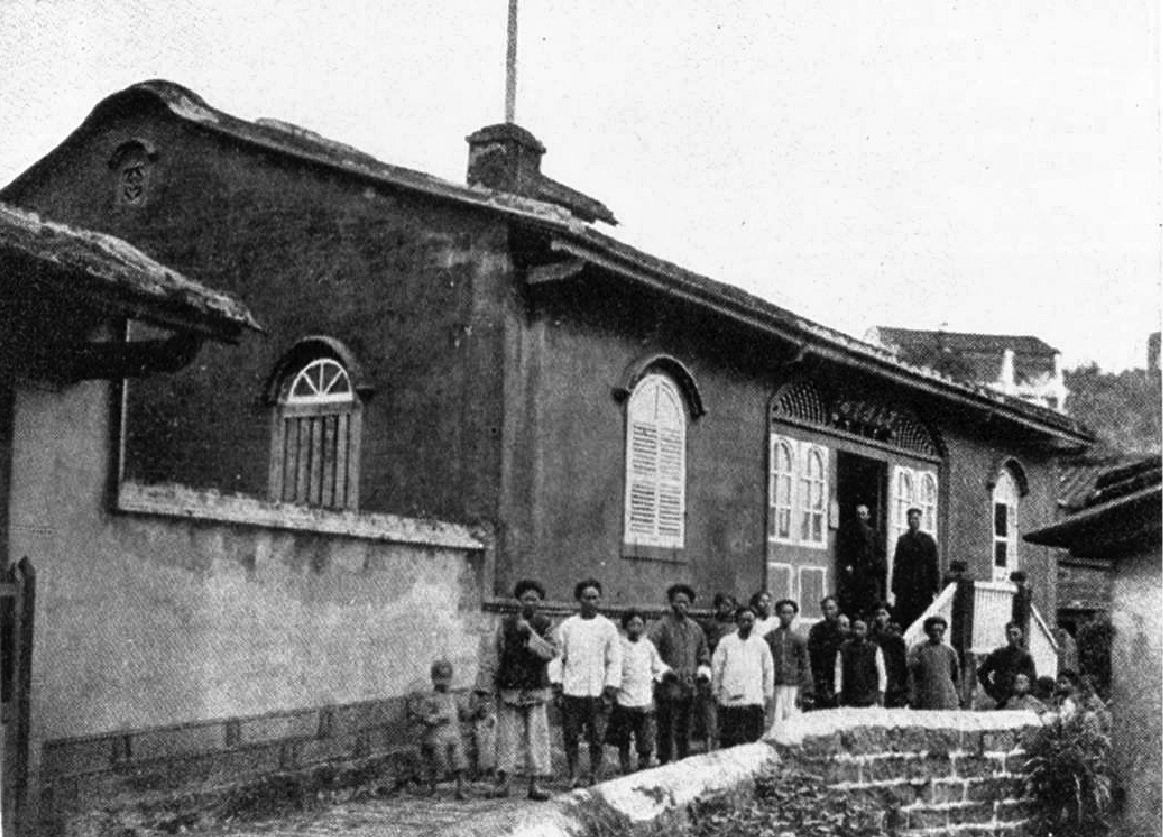 滬尾偕醫館
滬尾偕醫館 滬尾偕醫館 Ho-be MacKay Hospital
臺灣北部最早的西醫院,1879年由馬偕所建。馬偕於1872年來臺傳教,以滬尾(淡水)為據點,短短不到30年間,創設教會達六十多所,教區遍及北臺灣。馬偕傳教兼以行醫,1872年剛來淡水時,即在自寓施藥看診,之後因病患增加,另租民房做為醫館。其間有海關醫官林格醫師和加拿大教會派來的華雅各醫師等人協助醫療工作。後來因得到美國底特律馬偕船長夫人的捐助,興建滬尾偕醫館。
1884年清法戰爭時,偕醫館曾救治不少清軍傷兵。8月16日,兩名在基隆戰事中受重傷的士兵被抬來滬尾求醫。10月2日法艦炮擊滬尾清軍陣地,8名傷兵被送到偕醫館治療。10月8日登陸戰當天,有120名清兵送到醫館急救。戰事結束後,孫開華親自到偕醫館致謝並捐款。(文:張建隆)
This was the first Western-style hospital in northern Taiwan and was built by Rev. G. L. MacKay in 1879. MacKay came to Taiwan in 1872 and made Ho-be (Tamsui ) the base of his missionary activities. He went on to establish more than 60 churches throughout northern Taiwan in just 30 years. MacKay was both a missionary and a physician. When he first arrived in Tamsui, he set up a clinic in his home. As the number of patients grew, he moved his clinic to rented premises. His medical efforts were aided by Dr. Ringer, the Customs medical officer, Dr. Fraser, a Canadian missionary and others. The Mission Hospital was eventually built with the help of donations from Mrs. MacKay of Detroit, U.S.A.
The Hospital treated a number of Qing wounded during the Sino-French War of 1884. On August 16, two soldiers badly wounded during the Battle of Keelung were brought to Tamsui for treatment. After the French bombarded the Qing defenses at Ho-be on October 2, eight wounded soldiers were brought to the Hospital for treatment. A further 120 Qing soldiers were brought to the hospital for first-aid on October 2 after the landing. After the battle, General Sun Kai-hua personally visited the Hospital to express his gratitude and make a donation. (Text: Chang Jian-long)
福佑宮 Fuyou Temple
俗稱媽祖宮(臺語),主祀天上聖母。本廟草創於乾隆年間,約1782年,為昔日渡海來滬尾移民共同信仰中心,是淡水最早之廟宇。其後,由地方士紳發起募款,由滬尾街商民等合力集資,於嘉慶2年(1797)改築成日後規模宏偉之殿宇。前清及日治時期,曾經多次修繕,但大致保存原有風貌。1884年清法戰爭滬尾之役,相傳媽祖顯靈助陣,擊退法軍,事後獲頒光緒皇帝御筆「翌天昭佑」匾額,今仍高懸於正殿。據親見滬尾之役的地方宿儒雷俊臣口述,戰爭結束後,孫開華為陣亡官兵當起和尚,於福佑宮內舉行誦經超渡,涕零如雨。(文:張建隆)
Fuyou Temple is known to locals as Matsu Temple and is dedicated to Matsu. The temple was established around 1782 during the Qianlong Era and was the common religious center of early settlers in Hobe, making it the first temple in Tamsui. In 1797, local gentry and merchants raised the money to construct the magnificent temple complex we see today. The temple was renovated on several occasions during the Qing Dynasty and the Japanese colonial period, but the overall style remained little changed. The temple is therefore of tremendous architectural, artistic and cultural value. However, the most recent renovations to left and right side buildings failed to preserve the original architectural character. Hopefully, greater care will be taken with future renovations. Local legend says that Matsu’s divine intervention helped defeat the French troops at the Battle of Tamsui during the Sino-French War of 1884. An imperial plaque personally written by Emperor Guangxu was therefore bestowed upon the temple and this still hangs in the main hall today. Lei Jun-chen, a local scholar who witnessed the Battle of Tamsui, said that Sun Kai-hua became a monk after the war to pray for the officers and men killed in action. The prayer ceremony held at Fuyou Temple left Sun in tears. (Text: Jian-long Chang)
淡水清水巖 Tamsui Qingshui Temple
主祀蓬萊老祖,俗稱「落鼻祖師」,有別於他廟供奉之清水祖師,為本廟最大特色。相傳遇有災厄,落鼻祖師即以落鼻示警。蓬萊老祖本尊,約於前清道光年間,由興福寮村民自滬尾港恭迎至該村供奉。後由翁氏移至庄仔內祖厝奉祀,之後又移至滬尾街東興14番地(中正路12號)翁氏所經營之「濟生號」受滬尾街眾祈拜。相傳蓬萊老祖,治病救苦,驅除疫疾或病蟲害,十分靈驗,香火益盛。地方士紳於是發起建廟。經四處發動捐款,終於在1933年完成正殿建築,1937年完成前殿建築。1884年清法戰爭滬尾之役,相傳老祖顯靈,護佑滬尾街眾,事後獲頒光緒皇帝御筆「功資拯濟」匾額,今仍高懸於殿內。(文:張建隆)
The temple is dedicated to Penglai Laotsu, usually referred to as “Luobi Zushi”, while other temples are dedicated to Qingshui Zushi. It is said the nose of Luobi Zushi falls off as an omen of impending disaster. The main statue of Penglai Laotsu was brought from Hobe Harbor to Xingfuliao Village by the local villagers. Later, the statue was moved by the Ong clan to their ancestral shrine, then from there to “Jishenghao”, a store owned by the Ong family at Lot 14 on Hobe Street (no.12 Zhongzheng Rd.) where it was worshipped by the people of Hobe Street. Penglai Laotsu attracted a large following as it was believed to cure sickness, help those in need, as well as ward against illness and pests. A fund-raising campaign was therefore launched by the local gentry and the main temple hall. After much fund-raising, the main temple hall was completed in 1933 and the front was completed in 1937. Penglai Laotsu was said to have miraculously protected the people of Hobe Street during the Battle of Tamsui in the Sino-French War of 1884. An imperial plaque was therefore bestowed by Emperor Guangxu and this still hangs within the temple today. (Text: Jianlong Chang)
淡水龍山寺 Tamsui Longshan Temple
建於咸豐8年(1858)。為昔日三邑人(泉州晉江、惠安、南安三縣)的信仰中心。由當時在滬尾街經營船郊(貿易商行)的黃龍安發起,號召三邑人共同興建。並由洪光海、光城兄弟捐借祖產做為廟地,完成建造。淡水龍山寺主祀觀音菩薩,依佛誕、得道和出家紀念日,分別由晉江、惠安、南安三邑人代表主祭。而在農曆7月27日時由三邑人共同舉行普渡。這項傳統迄今維繫不墜,殊為難得。1884年清法戰爭滬尾之役,相傳觀音菩薩顯靈,免去滬尾街民遭受法艦炮彈波及之苦。事後獲頒光緒皇帝御筆「慈航普渡」匾額,今仍高懸於正殿。另,曾參與滬尾之役的的提督章高元,也於1885年捐獻寺廟中庭石材,今仍存於廟中。(文:張建隆)
The temple was constructed in the 8th year of the Jianfeng Era (1858) and was once the religious center of people from the three counties of Jinjiang, Hui-an and Nan-an in Quanzhou, China. Long-an Huang, a trader on Hobe Street, mobilized other people from his home counties to construct the temple. The brothers Guanghai Hong and Guangcheng Hong donated their family property for the temple site. Tamsui Longshan Temple is dedicated to Guanyin Buddha. Representatives from Jinjiang, Hui-an and Nan-an each host the temple ceremonies commemorating the Buddha’s birthday, ascension and renouncement of worldly ties respectively every year. People from all three counties also come together to host the Ghost Festival ceremony on the 27th day of the 7th lunar month. The tradition continues to today. Guanyin Buddha was said to have miraculously shielded the people of Hobe Street from the French bombardment during the Battle of Tamsui in the Sino-French War of 1884. An imperial plaque was therefore bestowed by Emperor Guangxu and this still hangs in the main hall today. Stone donated in 1885 by Governor Gaoyuan Zhang who took part in the Battle of Tamsui for the construction of the temple courtyard can still be seen as well. (Text: Jianlong Chang)
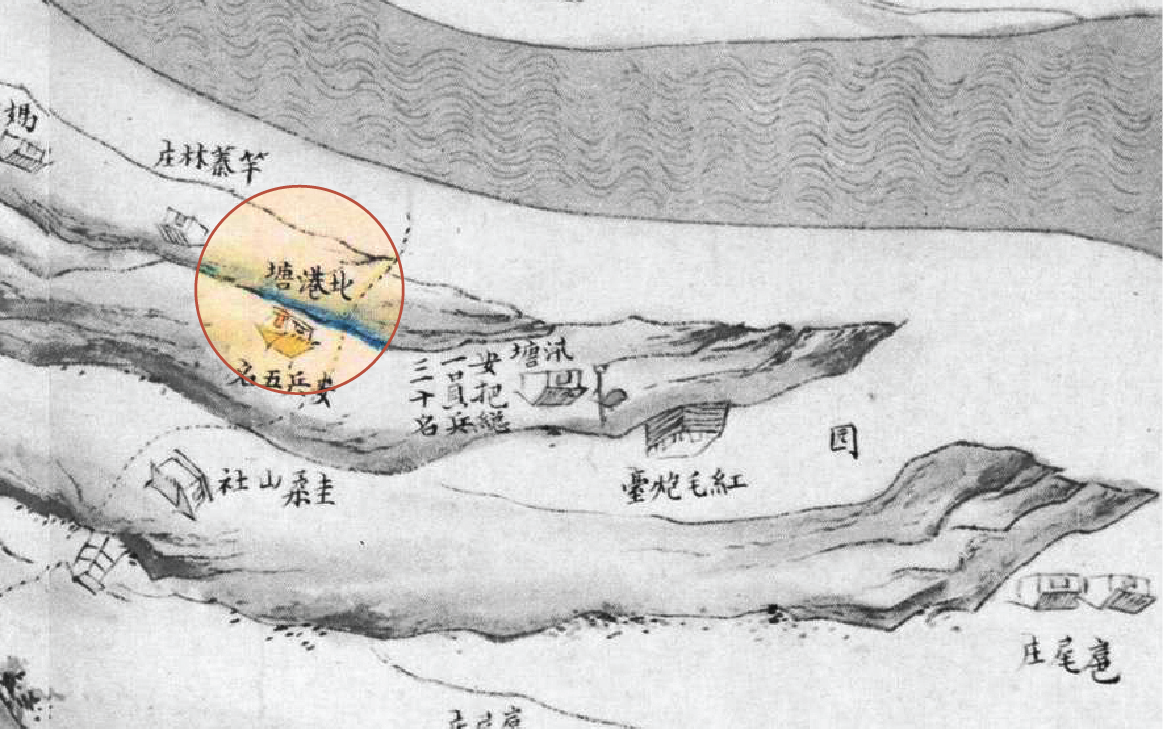 北港塘渡遺址地圖
北港塘渡遺址地圖北港塘渡遺址 Former Site of Beigangtang Landing
位於今聖江廟(文武尊王廟)廟埕前淡水河畔,為淡水最早的渡口(碼頭),設置年代不晚於乾隆7年(1742),為當時整個淡水河系僅有的6個渡口之一。清領之初,桃園往臺北皆沿海岸線北上,繞道南崁,至八里。八里至淡水,改搭船到北港塘渡口上岸。此處設有哨所,安兵駐守,因位於八里坌港的北岸而稱北港塘。「塘」即哨所之意。清朝兵制,營下設塘、汛,分布於交通要地。北港塘也是自八里坌渡河上岸到石門、金山、基隆陸路必經之地。因位居交通要衝,又設兵守,維護地方,成為滬尾街聚落較早發展之地。(文:張建隆)
The earliest wharf in Tamsui was located were Shenjiang Temple is today. (Wenwuzunwang Temple). The landing is known to have existed as early as 1742 (7th Year of Qianlong Era). At the time, it was one of only six crossings of the Tamsui River. During the early years of Qing rule, all travel from Taoyuan to Taipei followed the coast by way of Nankan and Bali. People used to take the boat to Tamsui from Bali and would disembarked at Beigangtang Landing. Guards were stationed here and as it was located on the north bank of Bengang in Bali, it was known as Beigangtang (literally “Northern Harbor Guard Post”). Under the Qing military system, garrisons were stationed along key routes. To reach Shihmen, Jinshan and Keelung by land from the landing, people had to pass through Beigangtang. Troops were therefore garrisoned at this strategic location to protect the local people. This was one of the earliest parts of Hobe Street to be developed. (Text: Chang Jian-long)
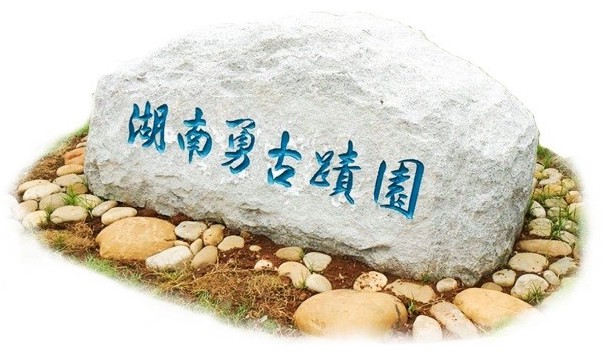 湖南勇古蹟園
湖南勇古蹟園湖南勇古蹟園 The cemetery of Hunan Braves
「滬尾湖南勇古墓」於1998年8月29日公告為市定古蹟,有清湖南兵勇古墓六座、觀音山石墓碑六方,碑首均刻有「擢勝左營」字樣。修復工程於2020年8月完工,命名為「湖南勇古蹟園」。
擢勝營為清湖南勇營之一,係因臺灣牡丹社事件,為籌辦海防由漳州鎮總兵孫開華所募,計分五營,勇員約2525人。擢勝中、左營為1880年為新建基隆沙灣礮臺及改建滬尾舊有露天礮隄而新編,次年1881年擢勝左營部分勇丁因故客死滬尾,未能於黔軍接防時趕回閩省,為擢勝左營留下歷史的見證。其中孫開華尤以第四次功勳最為顯著,是為1884年於滬尾參與清法戰爭戰勝法方,始其一躍成為抗法名將,且使擢勝營聲名耀然於史。
古墓墓區面積721.40平方公尺(約218.22坪),墓碑排列分散無一定秩序,但墓碑銘文刻法及內容則相當一致,左題刻有立碑朝代、年月份,皆為1881年,不同處為墓立月份,分別有8月一位、9月兩位、10月三位,大約是連續死亡擇地下葬;右題刻有墓主祖籍,5座屬「善化」,1座屬「永定」,均在湖南;墓碑中央刻有墓主身分及姓名,均刻「故勇」,意為已故勇丁,無頭銜及諡號,是勇營中最低階級,反映平民階級平實特色;墓主姓名分別為:李、袁、張、胡、嚴等,其中李姓占兩位;字體由上而下直書,特色為均以陰刻行書,大小均衡、刻痕不深、成鈍刀形、字跡相似,係出自同一人之手,可能是營勇中較具筆墨常識之勇員所為。
“The Cemetery of Hunan Braves” was designated as a municipal monument on August 29, 1998. There are six ancient graves. All were engraved with “ZhuoSheng Zuoying”, the left wing of ZhuoSheng battalion. The restoration was completed in August, 2020.
ZhuoSheng battalion was one of the five Hunan battalions in the Qing army. The Hunan battalions were commanded by Sun Kaihua, a Brigade General at Zhangzhou in Fujian, to reinforce the coastal defense force because of the Japanese invasion of Taiwan (1874). In 1881, some soldiers of the ZhuoSheng battalion died and were buried in Tamsui. The victory in Battle of Tamsui during Sino -French War earned Sun Kaihua instant fame and made the battalion a legend.
All of the inscriptions on the gravestones reveal that those soldiers died in different months of 1881. Their names, ancestral home Hunan Province, and "Guyong", ( “gu” means the deceased and “yong” means the lowest military rank) were also engraved.
Inscriptions were engraved with recessed letters, with similar calligraphy style and size. Presumably, they might have been crafted by the same soldier.